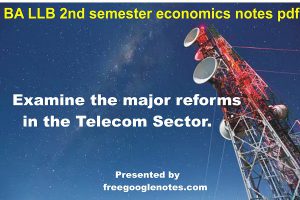Table of Contents
BA LLB 2nd semester economics notes pdf: Examine the major reforms in the Telecom Sector.
What you will learn here:
Telecom Policy reform in India

(1) Telecom equipment manufacturing was completely deregulated in 1991.
(2) Value-added services, including cellular phone services, were thrown open to the private sector in 1992.
(3) The National Telecom Policy (NTP) allowing private sector participation in basic services was announced in 1994.
(4) An independent regulatory authority called, Telecom Regulatory Authority of India (TRAI), was set up in 1997.
(5) A new policy for Internet Service Providers (ISPs) was announced in 1998, opening the area to private sector providers. The policy was promotional in nature. ISPs have been allowed to set up International internet Gateways (both satellite and landing stations) for submarine cable systems.
(6) A new policy called New Telecom Policy (NTP), 1999 was announced replacing the 1994 policy.
(7) Migration from the regime of fixed license fee to a new regime of revenue share was permitted in August 1999.
(8) The regulatory mechanism has been further strengthened through the TRAI (Amendment) Act, 2000. The Act provides for the establishment of a separate dispute settlement mechanism called Telecom Dispute Settlement and Appellate Tribunal.
(9) National Long Distance Service was opened for competition in August 2000.
(10) Corporation of Department of Telecommunication’s operational network into a public company called Bharat Sanchar Nigam Ltd., from October 1, 2000.
(11) Videsh Sanchar Nigam Ltd. (VSNL) and HTL have been dis-invested.
(12) The Communication Convergence Bill 2001 was introduced in Lok Sabha and has been referred to the Standing Committee of Parliament.
(13) Fourth Cellular Operator, one each in four metros, and thirteen circles have been permitted.
(14) Unrestricted entry in basic services allowed along with the use of wireless in local loop (WLL) access technology.
(15) Two categories of infrastructure providers have been allowed to provide end-to-end bandwidth and dark fiber, right of way, towers, duct space, etc.
(16) International Long Distance Services (ILDS) have been opened for competition since 1st April 2002.
(17) Internet Telephony has also been opened up since April 1, 2002.
(18) Guidelines for universal service obligation announced on March 27, 2002.
(19) Broadband Policy announced on October 14, 2004.
(20) Indoor use of low power equipment in 2.4 GHz band DE-licensed from August 2004.
(21) In April 2004, the license fee for the USA reduced by 2 percent in the range 6-10 percent while that for CMTs is in the range of 8-12 percent
(22) Performance Bank Guarantee in respect of NLDS license reduced in June 2004 from Rs. 100 crore to Rs. 50 crore for each phase.
(23) License for Infrastructure Provider-II reduced in June 2004 from 15 percent to 6 percent of the AGR.
(24) ISPs permitted to use underground copper cables for establishing their own last-mile linkages.
(25) In Budget 2004-05:
-Benefits under Section 80-IA provided for companies starting after May 31, 2005. -Customs duty exemptions provided on mobile switching centers for Unified Access Service Providers, optical fiber cable, and raw materials required for optical fiber.
(27) The operation of an automated spectrum management system has commenced.
(28) National Internet Exchanges set up during September 2003-February 2004.
(29) Guidelines issued for intra-circle mergers of licenses in January 2004.
(30) After the introduction of the Unified Access Service regime, all the Basic Service licensees have migrated to UASL.

